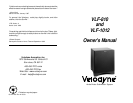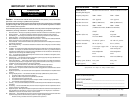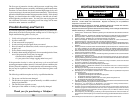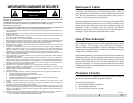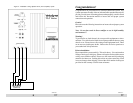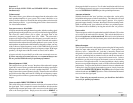
continued. . .
Caution! This subwoofer has electronics built into the cabinet. Do not
place the cabinet next to sources of heat such as furnace registers,
radiators, etc. Do not place the unit near sources of excessive moisture,
such as evaporative coolers, humidifiers, etc. The power cord should be
routed in such a way that it will not be walked on, pinched, or compressed
in any way that could result in damaging the insulation or wire.
Regardless of where you install your Velodyne subwoofer, it must remain
in an upright position (woofer facing forward). Using, shipping, or
otherwise storing the subwoofer in any other position for an extended
period of time may result in damage to the unit not covered by warranty.
The subwoofer is magnetically shielded to reduce the amount of stray
magnetic energy emitted from the speaker's motor structure. This greatly
increases flexibility when placing the unit close to video monitors as there
is very little stray magnetism. Certain types of televisions are particularly
sensitive to stray magnetic fields. If your television produces distorted
colors after installing your subwoofer, simply increase the distance
between your television and the subwoofer, until normal color and
operation is returned.
Your new Velodyne subwoofer, like any good speaker system, requires
proper positioning within the listening space to provide maximum
performance. Improperly placed speakers may degrade the sound quality
and reduce your listening pleasure. Depending on the size and type of
furnishings in the room, perfect placement may not be possible. Finding
the best location for your environment will likely require some
experimentation. We suggest you experiment with the location during
setup to find what sounds best to you when seated in your typical listening
position.
Installation
Inputs
Your new subwoofer is equipped with speaker-level and line-level inputs.
Use the LINE LEVEL jacks when connecting your subwoofer to a pre-amp,
signal processor, line-level crossover, or receiver with pre-amp level
outputs. The SPEAKER LEVEL jacks connect directly to the speaker
outputs of any amplifier, integrated amplifier, or receiver. Your amplifier
section will notice no additional loading effects when you use these inputs
due to their very high impedance.
continued. . .
6
☞
3
☞
Line-level Connection
Figure 1 shows connection to a pre-amplifier's main outputs and returning
them to your amplifier inputs.
When installed in this fashion, your satellite speakers will be crossed over
at 80Hz which removes the lower bass from your amplifier and speakers,
enabling them to do a better job reproducing high frequencies. By utilizing
this method, you will have a bi-amplified system, gaining improved power
and headroom for your system.
The Velodyne subwoofer is designed to operate using the full range audio
signal for input when using the built-in crossover. Some processors/
receivers, have a "subwoofer out" jack that is internally filtered and
designed to be used with a conventional amplifier and speaker. In some
rare cases, combining both an external crossover and the one internal to
the subwoofer may result in low output and increased noise. In these
installations you may need to bypass the internal crossover in either the
processor or Velodyne subwoofer. In some installations, simply setting
one crossover to a higher frequency (such as 120 Hz) will restore maximum
performance. To bypass the subwoofer's internal crossover when the unit
is being fed a low pass signal from another crossover, simply locate the
switch marked DIRECT/INTERNAL X-OVER on the rear panel of the
subwoofer and set to the DIRECT position. This will eliminate the internal
crossover from the signal path. Note: If not using an external crossover,
you should use the built-in crossover for optimal performance.
Speaker-level Connection
Figure 2 shows an easy way to connect your Velodyne subwoofer directly
to your receiver or integrated amplifier, if it lacks line-level outputs. You
may also connect your satellites directly to your receiver or amplifier along
with the subwoofer if you wish.
Caution!!! To avoid damage to your main amplifier, be sure to maintain
correct polarity when making all connections. Red (positive) to red, and
black (negative) to black. Be sure that all connections are tight, and that
there are no loose strands or frayed wires.



